(Online)
Vol. 8, Issue 2, pp: (126-140), Month: October 2020 - March 2021, Available at: www.researchpublish.com

(Online)
Vol. 8, Issue 2, pp: (126-140), Month: October 2020 - March 2021, Available at: www.researchpublish.com
1Dr. Manoj Kumar, 2Dr. Nishant Tyagi, 3Mahima Singla, 4Himanshu Bhatia, 5Aaeesha Vyas, 6Ved Sharma
1M.D., D.M. (Cardiology), FACC
Director Cardiology & HOD Cath Lab, Max Super Speciality Hospital, Patparganj, Delhi, India
2MBBS, MD Medicine, DNB Cardiology
Senior Consultant, Max Super Speciality Hospital, Patparganj, Delhi, India
3MSc., M. Phil.( Interdisciplinary Sciences) Product Manager, Butson Biosciences, Delhi, India
4M. Pharm (Pharmaceutical Sciences) Group Product Manager, Butson Biosciences, Delhi, India
5MBA
Assistant Product Development Manager, Butson Biosciences, Delhi, India
6Premedical Graduate Product Development Manager, Butson Biosciences, Delhi, India
Abstract: Low mortality rate of about 1.5% and optimism bias have changed the attitude of general public towards COVID-19. Though COVID-19 cases are increasing in India but mostly they remain in mild stage with 92.6% recovery and 1.48% mortality rate till 10th Nov. 2020 as per WHO reports. According to another study more than 75% of patients experience mild to moderate symptoms and recover without hospitalization. Just 5% patients progress to critical stage with 2-2.5% mortality rate. COVID-19 associated coagulopathy (CAC), the main cause of mortality have been reported mainly in subgroup of patients with comorbidities like CVD, hypertension, diabetes and cancer etc.
OBJECTIVE:- Our objective is to identify the factors responsible for COVID-19 symptoms progressing to life threatening CAC and their management.
DISCUSSION:- Excessive coagulation with fibrinolytic shutdown is the hallmark of CAC. Cytokine storm induced over expression of Tissue Factor is the potential trigger for CAC. Pharmacological properties of aspirin, like antiinflammatory and antithrombotic can be used as an evidence to hypothesize its use as a primary preventive treatment for CAC. Most of the patients are already taking aspirin for this purpose. But rising trend in aspirin resistance has made aspirin totally undependable. Omega-3 index (Omega-6/ omega-3 ratio) determines cardiovascular health. More than 8% is cardioprotective and less than 4% leads to major adverse cardiac events. Omega-3 reduces platelet aggregation, coagulation and thrombosis. High omega-6 levels cause coagulation. Omega-6 fatty acid (AA) is the substrate for the synthesis of a variety of proinflammatory/ proaggregatory molecule such as prostaglandin E2, thromboxane A2 (TXA2), & leukotriene B4.
International Journal of Healthcare Sciences ISSN 2348-5728 (Online)
Vol. 8, Issue 2, pp: (126-140), Month: October 2020 - March 2021, Available at: www.researchpublish.com
CONCLUSION:- Low Omega-3 index (High Omega-6/ omega-3 ratio) promotes coagulopathy. This can be corrected by adequate omega-3 nutrients (EPA and DHA) supplementation. Administration of EPA & DHA helps in replacing omega 6 fatty acids (such as AA) resulting in reduction of TXA2. Co-administration of Aspirin, EPA & DHA have shown positive results as an antiplatelet treatment. This also makes aspirin more effective by increasing its sensitivity. We hypothesize that co-adminisration of EPA + DHA + Aspirin may prove to be very useful as a primary preventive antithrombotic option in CVD patients. This can also check progression from mild COVID-19 symptoms to life threatening CAC.
Keywords: COVID-19, Aspirin, Omega-3 Fatty Acids, Coagulopathy.
COVID-19 is spreading like wildfire in jungles. All health agencies are trying to enforce strict laws to ensure its containment from spreading by wearing masks, hand sanitization & maintaining social distance. But still thousands of new cases are being reported everyday in India. This clearly shows that those people who are fed up with lockdown & suffer from „optimism bias‟ are venturing to go out & that too without wearing masks & with no provision of frequent hand wash & sanitization. In busy markets, there is hardly any room to maintain social distancing. In spite of all this, good number of patients (92.6%) suffering from COVID- 19 experience only mild to moderate symptoms & recover without hospitalization with 1.48% mortality rate In this largest study of over 44,000 patients with COVID-19, > 75% of cases were mild, 14% were severe, & 5% were critical, with an overall case fatality rate of 2–2.5% (1). Mortality has been reported mainly in subgroup of patients with co-morbidities. Patients without any co-morbidity had a mortality rate of 0.9% whereas those with co-morbidities like cardiovascular disease had mortality rate of 13.2%, Diabetes 9.2%, chronic respiratory disease 8%, hypertension 8.4% and cancer 7.6% (2).Viral infection associated inflammation clearly predisposes patients to prothrombotic states (3). Studies confirm that venous thromboembolism & arterial thrombosis have a high prevalence rate & a detrimental impact on prognosis of hospitalized patients (4, 5). According to various studies, since, aspirin resistance and low omega- 3 index also induce coagulopathy. So, we hypothesize that it might aggravate mild COVID-19 symptoms in CVD patients taking aspirin with low omega-3 index leading to life threatening COVID-19 associated coagulopathy (CAC) resulting in high mortality.
Type- 1 & type- 2 pneumocytes have different functions. Type-1 is engaged in gaseous exchange (6, 7) & type-2 maintains elasticity in alveoli for expanding during inhalation & exhalation (6, 8 and 9). The main target of SARS-CoV2 is type-2 pneumocytes because ACE-2 receptors are found in abundance in them as compared to type-1. In type-2 pneumocytes SARS CoV2 infects & enters the cells. There it initiates its RNA multiplication, which gives rise to thousands of virus copies leading to rupturing of pneumocytes & their release (6, 10). This can infect other type-2 pneumocytes. They also enter blood circulation to reach all organs having ACE-2 receptors like cardiovascular system, G.I. tract, kidney etc. (6, 11).
Inflammation is body‟s first line of defense against infection and injury. After its initiation it should be subsided otherwise it becomes harmful to the body. Body has its own anti-inflammatory system as well to resolve inflammation. Thrombosis & inflammation go hand in hand in COVID-19. They become injurious to the host in direct proportion to the disease severity if it remains unchecked (12). Ruptured type-2 pneumocytes attract macrophages through production of host defense mechanisms which include proinflammatory cytokines such as interleukin (IL)-1β, IL-6, tumor necrosis factor-α (TNFα), & complement system proteins, all of which specifically raised IL-6 can induce coagulopathy (13). This can lead to endothelial dysfunction, vascular damage, sepsis, hypercoagulation & multi organ injury i.e. Brain, Heart, Lungs, Kidneys and G.I. Tract (Fig 1)
(Online)
Vol. 8, Issue 2, pp: (126-140), Month: October 2020 - March 2021, Available at: www.researchpublish.com
Fig 1: Mechanisms of SARS-CoV-2 associated cytokine storm. Infection with SARS-CoV 2 can stimulate a hyperinflammatory immune response wherein epithelial-cell-mediated production of reactive oxygen species (ROS) can also stimulate the synthesis of NF-κB which contribute to increased cytokine levels of ↑IL-1, ↑IL-2, ↑IL-6, ↑TNF-α, ↑IFN-γ (CYTOKINE STORM). This essentially causes immune invasion which can lead to clinically relevant conditions such as ARDS, sepsis, multiple organ dysfunction syndrome(MODS) & death. All organs (like heart, lungs, kidneys, brain & G.I. tract) having ACE-2 receptors are always vulnerable to SARS-CoV2 infection. SARS-CoV-2, severe acute respiratory syndrome coronavirus 2; COVID-19, coronavirus disease 2019; ROS, reactive oxygen species; NF-κB, nuclear factor kappa-light-chain-enhancer of activated B cells; IL, interleukin; TNF, tumor necrosis factor; IFN, interferon; MODS, multiple organ dysfunction syndrome
COX-2 plays a dual role in inflammatory process, i.e. pro-inflammatory and anti-inflammatory (Resolution). In the inflammatory phase COX-2 promotes generation of pro-inflammatory lipid mediators from Arachidonic Acid like prostaglandins (PGs) and leukotrienes (LTs) and in the anti- inflammatory phase, it promotes generation of pro- resolvins from Omega- 3 fatty acid nutrients (EPA & DHA). This depends upon presence or absence of aspirin. EPA + DHA are the necessary building blocks of resolvins. On the contrary, Omega- 6 (AA) generates pro- inflammatory eicosanoids. Using the same COX and LOX enzymes operative during the initiation of acute inflammation, the host is able to shift the chemical mediator profile from pro-inflammatory to pro-resolving by modulating biosynthetic pathways to induce 15LOX expression and activity to generate LXs, RVs and PD1.
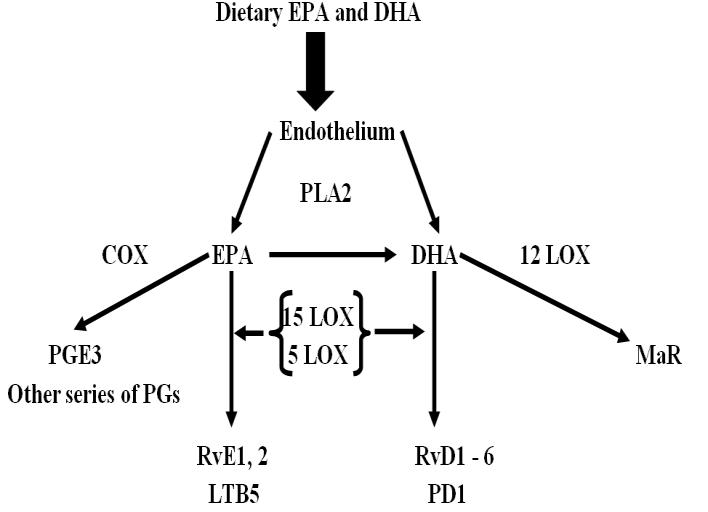
Resolvins are specialized pro-resolving lipid autacoids mediators (SPMs). They are divided into two classes i.e. EPA derived E- series (RvE1, RvE2, & RvE3) & DHA derived D- series (RvD1, RvD2 & RvD3) (Fig 2) (14). Resolvins reduce inflammation by blocking trans endothelial migration, regulate interleukin 12 production & lead to resolution of the inflammatory response to resolve inflammation. Resolvin molecules do not inhibit the onset of inflammation but stimulate its resolution pathways. They promote the resolution of the inflammatory cycle. They also stimulate the phagocytosis of apoptotic PMNs by macrophages and selectively disrupt thromboxane-mediated platelet aggregation.
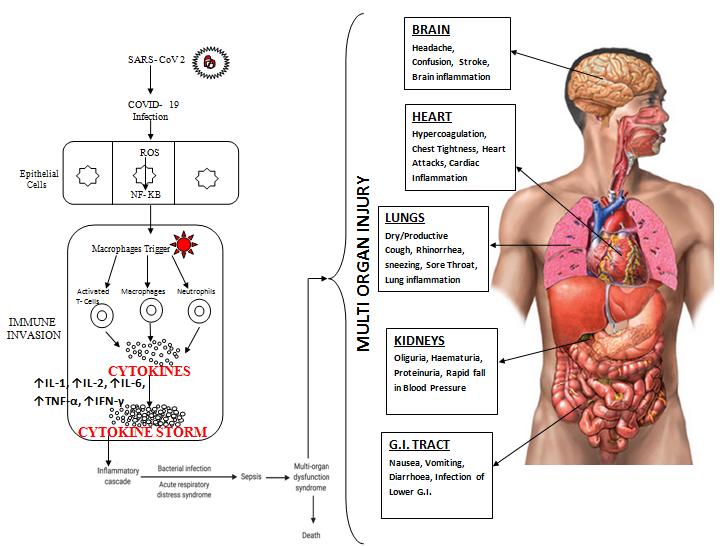
International Journal of Healthcare Sciences ISSN 2348-5728 (Online)
Vol. 8, Issue 2, pp: (126-140), Month: October 2020 - March 2021, Available at: www.researchpublish.com
Fig 2: Formation of anti-inflammatory metabolites by metabolism of DHA and EPA. These metabolites bind to their respective receptors & elicit anti-inflammatory changes in cells. It leads to decrease in IL-6, IL-1, or TNFα, key cytokines provoking cytokine storm. (PLA2, phospholipase A2; EPA, eicosapentaenoic acid; DHA, docosahexaenoic acid; LOX, Lipoxygenase; PGs, Prostaglandins; PGE3, Prostaglandin E3; RvE1,2, Resolvin E1 & E2; LTB5, Leukotriene B5; RvD16, D-series resolvins; PD1, Protectin D1; MaR, Maresin)

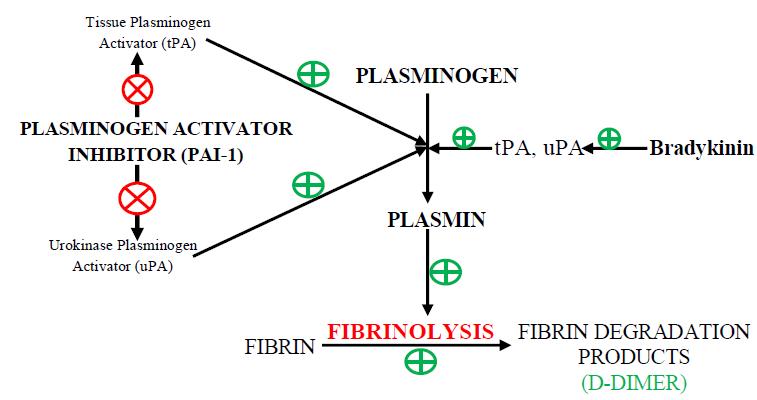
Hyperinflammation (Cytokine Storm) is the result of much higher production of proinflammatory mediators (IL-6, IL-1β, TNF-α etc.) than proresolvins to resolve inflammation. Deficit in resolution result in hyperinflammation.
The main underlying mechanism responsible for higher coagulation tendency during COVID-19 is over- activation of immune system causing complement release syndrome. Elevated IL-6 the immunomodulator is the trigger factor for coagulation disorders (15).
SARS- COV-2 induced infection can lead to arterial & venous thromboembolic events by either inducing excessive systemic inflammatory response, pro-coagulant activity, immobilization, & hypoxia, or causing DIC (16, 17 and 18). DIC is characterized by systemic intravascular activation of coagulation, leading to the deposition of fibrin & formation of widespread micro vascular thrombosis. Pulmonary intravascular coagulation (PIC) is distinct from DIC as it is immune thrombosis (19).
Elevated levels of fibrinogen and D-dimer & mild prolongation in PT/aPTT were seen in patients with CAC. This correlates with a parallel rise in markers of inflammation (e.g. CRP) unlike the pattern seen in classic DIC from bacterial sepsis or trauma, prolongation of the aPTT and/or PT is minimal, thrombocytopenia is mild (platelet count ~100 x109/L) (Table 1) (20).
Table 1: DIFFERENCE BETWEEN CAC & DIC
International Journal of Healthcare Sciences ISSN 2348-5728 (Online)
Vol. 8, Issue 2, pp: (126-140), Month: October 2020 - March 2021, Available at: www.researchpublish.com
Fig 3 : (A) Generation of plasmin, the fibrinolytic enzyme, follows the activation of plasminogen by plasminogen activators (PA; tissue-type PA [tPA] & urokinase-type PA [uPA]), which are themselves inhibited by type 1 plasminogen activator inhibitor (PAI-1). The enzymatic activity of plasmin is inhibited by 2-antiplasmin (2-AP; & potentially by 2macroglobulin) (21). (B) The direct infection of endothelial cells by the virus (a mechanism that is rather specific for coronaviruses via their cell entry through ACE2 (angiotensin-converting enzyme 2, the receptor for SARS-CoV-2), abundantly expressed on endothelium) leads to a massive release of plasminogen activators (22). ACE2 helps to mediate anticoagulant properties of the vascular endothelium in the healthy state, binding of SARS-CoV-2 to ACE2 aggravates cell damage, upregulates tissue factor expression (23). SARS- CoV- 2 binds to the ACE -2 Receptor which is an important Component for Renin Angiotensin System. Due to overusage of ACE 2, it will result in excess of Angiotensin 2 which is stimulator of PAI-1; this inhibits the action of Plasminogen activator which helps in fibrinolysis by converting Plasminogen to Plasmin.
Excessive coagulation with fibrinolytic shutdown is the hallmark of CAC (Fig 3). This is a big challenge to treat critical COVID- 19 patients. Best option is to check its progression right from mild stage to critical one.
Cytokine storm induced over expression of Tissue Factor is the potential trigger for CAC. Tissues of lungs, brain & surface of cells like endothelial cells, macrophages & monocytes store tissue factor (TF). Normally they are not in circulation. But after vascular injury, they get exposed to blood & platelets. Cytokines like IL-1, TNFα & endotoxins help their release in blood which makes it critical mediator leading to easy & fast development to CAC. TF binds with activated factor VIIa when exposed to both platelets & blood. They then promote the activation of factor IX & X to IXa & Xa, respectively, ultimately results in common coagulation pathway & the consequent formation of both thrombin & fibrin (Fig 4) (24, 25, and 26). These micro thrombi impair organ perfusion & in turn lead to organ failure. Increased activity of coagulation cascade results in the formation of more fibrin clots in blood which finally leads to the deposition of platelets on it & hence, increasing the size of these formed clots. Large clots will result in blockage of blood vessels & cause life threatening embolism due to CAC. During the whole process, coagulation inhibitors get used up which further worsens this ongoing condition because reduced inhibition will lead to increased coagulation. Elevations in fibrinogen levels & D- dimer levels are also observed. This correlates with a simultaneous increase in inflammatory markers (e.g. CRP).
Fig 4:- Tissue factor (TF) (also called as platelet tissue factor, factor III & CD142) released in response to the cytokines like IL-1, TNFα & endotoxin leads to coagulation. Increase in tissue factor results in activation of coagulation cascade by activating factor VII to VIIa which further activates other coagulation factors like IX & X to IXa & Xa respectively & subsequently form thrombin & fibrin.
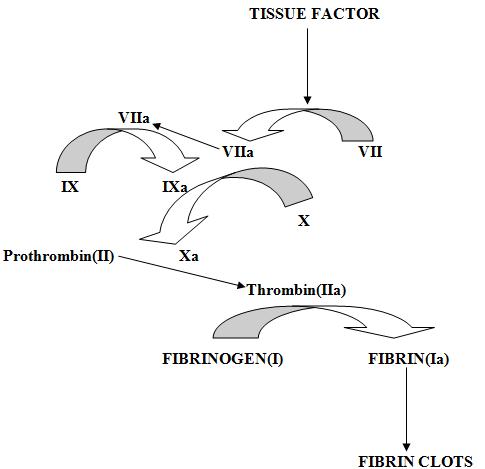
Aspirin is found to have a lot of pharmacological properties due to its binding & inhibition of COX enzyme & many other pharmacologically active sites (27). Aspirin is useful as an antipyretic & analgesic. But the antithrombotic & anti- clotting property made it distinct from other popular NSAIDs like Ibuprofen or paracetamol. This property has also attracted the interest of many scientists to find its potential benefits & provide a supportive therapy for COVID-19 induced
International Journal of Healthcare Sciences ISSN 2348-5728 (Online)
Vol. 8, Issue 2, pp: (126-140), Month: October 2020 - March 2021, Available at: www.researchpublish.com
coagulopathy. Moreover, it also reduces the symptoms like pain & fever during SARS-CoV2 infection. Also it can stop progression of cases to life threatening stage by its anti-inflammatory, antithrombotic & antiviral effects (27, 28, 29, 30, 31 and 32).
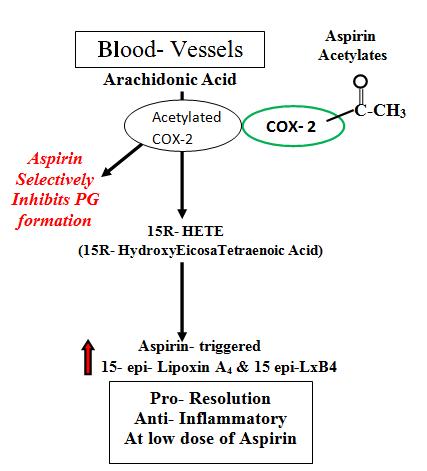
Aspirin used in an in-vitro study has shown an antiviral effect on other previous human coronavirus like MERS CoV & SARS CoV. It impairs the progression of these viruses by inhibiting virus induced NF-kB activity during replication, resulting in reduced number of copies & act as a virostatic agent in smooth muscles (33, 34). Aspirin got a lot of popularity during the last pandemic of Spanish flu in 1918. In a study Aspirin was found to be effective against influenza virus by inhibiting prostaglandin E2 (PGE2) in macrophages & increased the production of interferon type 1(INF-1), results in reduced viral multiplication & increased immune response governed by T-cells (33, 34).
(a) (b)
Fig. 5: Role of Aspirin in (a) Thromboinflammation and (b) Antithrombotic
Distinct series of pro-resolving lipid mediators are generated, depending on the parent substrate and the presence or absence of aspirin. Expression of COX-2 is increased during acute inflammation (35) and the ingestion of aspirin leads to acetylation of COX-2, which blocks PG formation (36). COX- 2 initiation of leukotriene synthesis is prevented by acetylation (37, 38). Acetylated COX-2 is not catalytically inactive, converts arachidonic acid to 15(R)-HETE rather than PGs (39). 15(R)-HETE can serve as a substrate for 5-LOX for transformation to 15(R)-LXA4. Aspirin-triggered 15-epiLXs are ~twofold more potent than 15(S)-LXs (13). Aspirin can trigger the synthesis of stereoisomers (epimers) of LXA4 & LXB4 (these compounds are also referred to as Aspirin-Triggered Lipoxins (ATLs)). The biochemical synthesis of these protective compounds is enzymatically mediated (Fig. 5 (a))
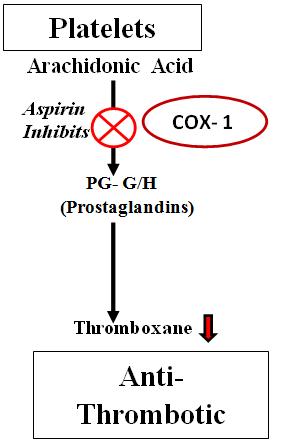
Aspirin is unique among other NSAIDs because it irreversibly inhibits COX-2 by acetylation of an amino acid serine residue preventing prostanoid generation yet enabling the biosynthesis of endogenous anti-inflammatory mediators. Lowdose ASA triggers the resolution phase by activating endogenous epimers of specialized pro-resolving lipid mediators in humans. Low-dose ASA may be considered “resolution friendly” since it mimics endogenous biosynthetic mechanisms to trigger new mediators, leading to a favourable net change for pro-resolution.
Aspirin is the most trusted antiplatelet drug because of its high selectivity to COX-1 inhibition (40). According to the study, Inhibition of COX-1 by aspirin is 10 times greater than that of COX-2 (IC50 3.5 v/s IC50 30 µM) (41, 42 and 43). Aspirin at lower dose of 75-100 mg irreversibly acetylate Ser530 site of COX-1 & inhibits formation of TXA2, a vasoconstrictor & platelet aggregator (44). Aspirin induced inhibition of TXA2 makes it a significant antithrombotic agent (Fig 5(b)) (45).
International Journal of Healthcare Sciences ISSN 2348-5728 (Online)
Vol. 8, Issue 2, pp: (126-140), Month: October 2020 - March 2021, Available at: www.researchpublish.com
Pharmacological properties of aspirin, like anti-inflammatory, antithrombotic and antiviral can be used as an evidence to hypothesize its use as a primary preventive treatment for CAC. But rising trend in aspirin resistance has made aspirin totally undependable. Restoring aspirin sensitivity to its original status may be useful as a treatment protocol in coagulopathy especially in CAC.
Aspirin resistance is an inactivity of aspirin to decrease TXA2 formation & in turn platelet aggregation & activation. Aspirin resistance doesn‟t refer to an absence of expected antiplatelet activity of aspirin only but also poor clinical outcomes, like 3 fold higher risk of death, heart attack & stroke (46).
Aspirin resistance was defined by the presence of at least 2 of the following 3 criteria: 0.5-mg/ml AA-induced platelet aggregation >20%, 10 µmol/l ADP-induced aggregation >70% & ARU >550 (in contrast to the screening process in which an ARU {Aspirin Reaction Unit} >500 was used as the cutoff) (47). Time tested activities of aspirin can prove to be useful in COVID-19. The main hindrance in aspirin usage is high prevalence of aspirin resistance among mass population i.e. 24.75% in CVD patients as per WHO cardiovascular disease (CVD) factsheet 2017 (48). According to another study its prevalence is 5-75% (49) & 38.1% in Indian patients with documented heart disease (50) .Up to 40% of patients with CVD do not comply with Aspirin (51).
The Omega-3 Index test is simply a measure of the amount of EPA & DHA in the blood, specifically the red blood cell membranes. For example, if you have 68 fatty acids in a cell membrane & 4 are EPA & DHA, then you would have an Omega-3 Index of 5.88%. When you take an Omega-3 Index test it gives you a percentage. Low omega-3 index (≤ 4%) is an independent risk factor for CHD mortality (52).Whereas, ≥8% is cardioprotective (53). Low Omega- 3 index reflects high Omega- 6/ Omega- 3 ratio.
4.3
Omega-6 fatty acid (AA) is the substrate for the synthesis of a variety of proinflammatory/ proaggregatory molecule such as prostaglandin E2, thromboxane A2 (TXA2), & leukotriene B4. High omega-6 concentration overproduce them leading to coagulation (54). TXA2 has prothrombic properties, as it stimulates the activation of platelets & platelet aggregation. TXA2 is also a known vasoconstrictor & gets activated during times of tissue injury & inflammation (55). Leukotriene B4, a powerful inducer of leukocyte chemotaxis & adherence also induce coagulation.
4.4 HIGH OMEGA-6/OMEGA-3
High Omega-6/Omega-3 ratio shifts the balance into pro-inflammatory/pro-aggregatory state. Data collected from various sources confirm the high prevalence of omega-6/omega-3 ratio (15- 17/1) in almost all worst affected countries (Table 2)
ESSENTIAL FATTY ACID STATUS
Table 2: Table showing country-wise total number of COVID- 19 cases till 8th October, 2020 S.No. COUNTRY COVID- 19 Cases Omega- 3 Index Omega-6/ Omega-3 Ratio 1 U. S. A. 77,76,796 ≤ 4% 15 - 17/1 2 India 68,35,655 ≤ 4% 37/1 ** 3 Brazil 50,02,357 ≤ 4% 15 - 17/1 4 Russia 12,60,112 > 4 to 6% (6.39/1)* 5 Spain 8,72,276 > 4 to 6% 15 - 17/1 6 Mexico 7,99,188 N/A 15 - 17/1 7 France 6,53,509 > 4 to 6% 15 - 17/1 8 U. K. 5,44,275 ≤ 4% 15 - 17/1 9 Iran 4,83,844 ≤ 4% NA 10 Italy 3,33,940 ≤ 4% 15 - 17/1 11 Germany 3,11,113 > 4 to 6% 15 - 17/1 **As per Urban Indian Diet (56). * Calculated from omega-6 & omega-3 intake {Total omega-6(LA+AA)/Total omega-3(ALA+EPA+DHA)} (57).
International Journal of Healthcare Sciences ISSN 2348-5728 (Online)
Vol. 8, Issue 2, pp: (126-140), Month: October 2020 - March 2021, Available at: www.researchpublish.com
Aspirin resistance problem can only be solved by minimizing thromboxane A2 production by co-administration of another substance with aspirin which could manage to reduce the TXA2 production. This can be achieved with co-administration of EPA & DHA with aspirin. Their supplementation helps in replacing omega 6 fatty acids (such as AA). This increase in EPA/AA ratio will ultimately help in reduction of TXA2. There are various studies which have shown a synergistic effect of low dose aspirin with EPA & DHA supplementation. These studies have proved that this combination is an effective antithrombotic treatment. In a study TXB2 (inactive metabolite of TXA2) was evaluated & reduction of 56.8% with EPA, DHA & low dose aspirin in 30 days were reported (58) Aspirin‟s antiplatelet effect is also enhanced by omega-3 fatty acids. Increase in bleeding time by 33% is also observed in 11 weeks due to TXA2 inhibition (59). In another study combination of aspirin, EPA & DHA have shown positive result as antiplatelet but as individual they are not much effective (60). The effects of aspirin and fish oil consumption on lysophosphatidylcholines and lysophosphatidic acids and their correlates with platelet aggregation in adults with diabetes mellitus (61)
In a dose dependent study (3-4g EPA + DHA/d v/s 1g EPA + DHA/d) there was significant 7.5 fold decrease in tissue factor (-5.3vs -0.7), 22 times in IL-6 and 2 times in TNF-α at higher doses (62).
Dietary omega-3 fatty acids like DHA reduce inflammatory eicosanoid production from Arachidonic Acid (AA) (63), adhesion molecules (VCAM-1 & ICAM-1) (64), chemokines (MCP1) (65), matrix metalloproteinases & inflammatory cytokines (66). Mammalian cells lack conversion of omega-6 to omega-3 fatty acids because of the absence of converting enzyme, i.e., omega-3 desaturase (State of high Omega-6/ Omega-3 ratio). This condition is associated with increased production of thromboxane A2 (TXA2), leukotriene-B4 (LTB-4), IL-1, IL-6, tumor necrosis factor (TNF) & C-reactive protein which increase by increased intake of omega-6 fatty acid & decrease by increased intake of EPA & DHA. Omega3 PUFAs for 4 weeks lowered fibrinogen, thrombin & factor V levels (67). 2 to 3 grams of EPA per day for 11 weeks prolonged bleeding time by 33% (68). High-dose (1.5 g/day EPA + 1.0 g/day DHA) n-3 supplementation can reduce plasma levels of both IL-6 and IL-1ß (69). The anti-inflammatory effect of EPA and DHA supplementation seems consistent (70)
Fig 6: Biological & metabolic roles of omega-6 & omega-3 fatty acids.
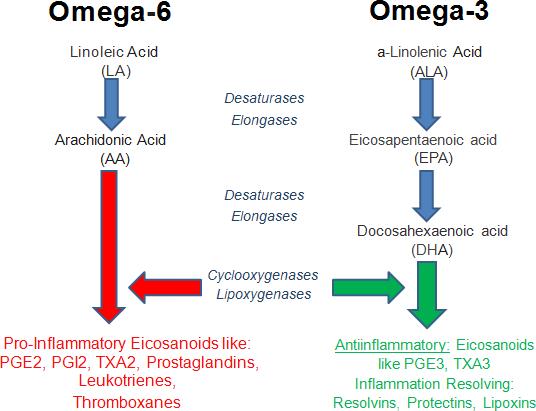
International Journal of Healthcare Sciences ISSN 2348-5728 (Online)
Vol. 8, Issue 2, pp: (126-140), Month: October 2020 - March 2021, Available at: www.researchpublish.com
Fig 7: Role of Omega-3 nutrients as anti-platelet aggregators. DHA downregulates( ) Thromboxane A2 whereas, EPA upregulates( ) Thromboxane A3, both of which reduces platelet aggregation. Also EPA derived Prostacyclin I 3 reduces chances of bleeding (71, 72).
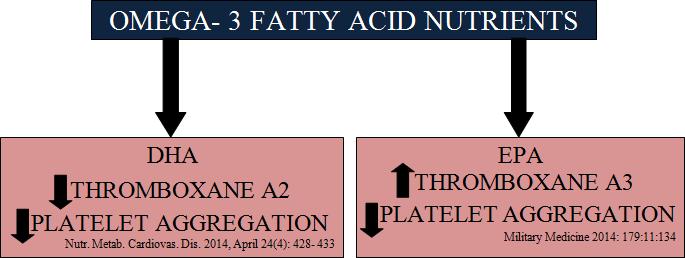
Eating more EPA+DHA can prevent chronic low-grade inflammation (73). Both EPA & DHA have anti-inflammatory benefits (Fig 6) (73). Both EPA & DHA inhibit platelet aggregation (74, 75). They directly & indirectly reduces the formation of the AA proaggregatory metabolite TXA2 (Fig 7) (76). The assimilation of omega-3s in red blood cells seems to reduce whole blood viscosity & increase red blood cell flexibility thus reduces the risk of thrombosis (74, 75). Daily supplementation with 3 g of EPA/DHA for 18 weeks, showed anti- thrombotic effects of omega-3s in clinical studies in healthy patients. The long chain omega-3 PUFAs EPA & DHA have anti-platelet effect (77).
Omega- 3 fatty acids (EPA + DHA) supplementation exerts their anti- inflammatory actions by competing with omega- 6 (Arachidonic Acid), reducing pro- inflammatory eicosanoids and increasing proresolvins (Fig 8) (78). Aspirin induces synthesis of Resolvins & the Protectins with the help of EPA and DHA (79, 80, 81 and 82). A combination of aspirin & omega-3 PUFAs (EPA + DHA) is an effective prevention strategy in cardiovascular diseases. Aspirin, EPA and DHA combination not only prevents the onset of inflammation but also resolves it (83).
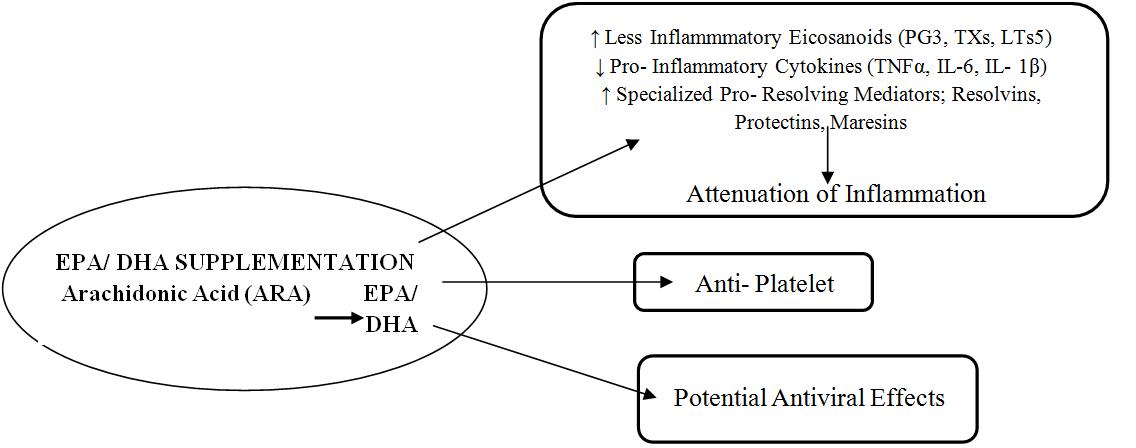
So activation of body‟s own resolution pathways with low dose aspirin + EPA + DHA may become novel therapeutic approach to limit thromboembolism in CVD and especially CAC and improve outcome in severe COVID-19 patients (84)
To identify relevant studies, a comprehensive literature search was conducted. Supplementary literature searches included examining the reference lists of all relevant studies, pertinent review articles, & meta- analyses. Our objective was to systematically review the available literature & to identity the relationship between aspirin resistance, low omega- 3 index (EPA + DHA levels), high omega-6/omega-3ratio & COVID- 19 induced coagulation WHO has stated that there should be an optimal balance in the dietary intake constituted by n-6 & n-3 PUFA (85). However, n-6 PUFA are found in large
International Journal of Healthcare Sciences ISSN 2348-5728 (Online)
Vol. 8, Issue 2, pp: (126-140), Month: October 2020 - March 2021, Available at: www.researchpublish.com
amounts in most plant oils & its consumption has exploded in the past decades while fish consumption has steadily declined (86). Over-supply of omega-6 PUFAs and under-supply of omega-3 nutrients lead to striking imbalance between these two. This decreases omega- 3 index and increases omega- 6/ omega- 3 ratio. This can substantially increase the chances of thromboinflammation.
According to various studies aspirin resistance is quite common in aspirin taking patients. So we hypothesize that, aspirin resistance and low omega- 3 index in CVD patients can trigger coagulopathy specifically CAC in COVID- 19. Hence coadministration of another substance which can reduce TXA2 is required to potentiate aspirin‟s anti-thrombotic actions and overcome aspirin resistance. Adequate intake of 3- 4 grams/ day of EPA + DHA not only meet these requirements but also increases omega- 3 index and reduces omega- 6/ omega- 3 ratios. This along with low dose aspirin can help in resolving cytokine storm and check progression of COVID- 19 to severe stage Resolving inflammation with aspirin and resolvins producing EPA + DHA is a better and effective way to subside cytokine storm than COX-2 inhibitors like NSAIDs
We don‟t claim that high omega-6/omega-3 ratio is the only contributory factor causing high mortality. It can be one of the major factor besides median age, immunity etc. To the best of our knowledge this is the first study correlating aspirin resistance and low omega-3 index i.e., high omega-6/omega-3 ratio with severity and mortality in COVID-19 patients. Adequate supplementation of omega- 3 nutrients i.e., EPA & DHA may help in correcting this harmful imbalance. We propose that there is a need for further research and clinical trials to establish this hypothesis of combined therapy of aspirin, EPA and DHA. This can improve both aspirin efficacy as well as Omega-3 index resulting in decreased Omega6/Omega-3 ratio. This might help in keeping COVID-19 symptoms in mild stage & check their progression to life threatening CAC.
International Journal of Healthcare Sciences ISSN 2348-5728 (Online)
Vol. 8, Issue 2, pp: (126-140), Month: October 2020 - March 2021, Available at: www.researchpublish.com
34. TF Tissue Factor 35. HETE Hydroxyeicosatetraenoic Acid 36. LXA4 Lipoxin A4 37. ATLs Aspirin Triggered Lipoxins 38. ASA Acetyl Salicylic Acid 39. IC50 Half Maximal Inhibitory Concentration 40. TXA2 Thromboxane A2 41. ADP Adenosine Diphosphate 42. ARU Aspirin Reaction Unit 43. WHO World Health Organisation 44. CHD Coronary Heart Disease 45. CAD Coronary Artery Disease 46. LA Linolenic Acid 47. ALA Alpha-Linolenic Acid 48. TXB2 Thromboxane B2 49. VCAM-1 Vascular Cell Adhesion Molecule 1 50. ICAM-1 Intercellular Adhesion Molecule 1 51. MCP1 Monocyte Chemoattractant Protein-1 52. PUFAs Poly Unsaturated Fatty Acids 53. NSAIDs Non Steroidal Anti-Inflammatory Drugs
[1] Wu Z, McGoogan JM. Characteristics of & important lessons from the coronavirus disease 2019 (COVID-19) outbreak in China: Summary of a report of 72314 cases from the Chinese Center for Disease Control & Prevention. JAMA 2020; 323: 1239–1242.
[2] Worldometers.info/coronavirus/.
[3] Giannis D, Ziogas IA. Gianni P. Coagulation disorders in coronavirus infected patients: COVID-19, SARS- CoV-I, MERS-CoV and lessons from the past. J Clin Virol 2020: 127:104362.
[4] Tang N, Li D, Wang X, Sun Z. Abnormal coagulation parameters are associated with poor prognosis in patients with novel coronavirus pneumonia. J Thromb Haemost 2020; 18: 844–7.
[5] Helms J, Tacquard C, Severac F, Leonard-Lorant I, Ohana M, Delabranche X et al (2020) CRICS TRIGGERSEP Group (Clinical Research in Intensive Care & Sepsis Trial Group for Global Evaluation & Research in Sepsis).
[6] Faiq MA, Kumar A, Singh HN, Pareek V, Qadri R, Raza K, et al. COVID19: A review on molecular basis, pathogenic mechanisms, therapeutic aspects & future projections. doi: 10.20944/preprints202004.0091.v1.
[7] Ward HE, Nicholas TE. Alveolar type I & type II cells. Aust N Z J Med. 1984; 14(5 Suppl 3):731-4.
[8] Sugahara, K. [Regulation of alveolar type II cell proliferation & surfactant gene expression]. Nihon Kyobu Shikkan Gakkai Zasshi. 1994;32 Suppl:73-8.
[9] Helewski K, Konecki J. [Alveolar cells type II, their role in the biosynthesis of pulmonary surfactant & other functions]. Pol Tyg Lek. 1989; 44(2-3):58- 62.
[10] Zinzula L, Tramontano E. Strategies of highly pathogenic RNA viruses to block dsRNA detection by RIG-I-like receptors: hide, mask, hit. Antiviral Res. 2013; 100(3):615-35. doi: 10.1016/j.antiviral.2013.10.002.
[11] Cascella M, Rajnik M, Cuomo A, Dulebohn SC, Di Napoli R. Features, Evaluation & Treatment Coronavirus (COVID-19). In: StatPearls. Treasure Island (FL): StatPearls Publishing; 2020.
[12] Iba T, Levy JH. Inflammation & thrombosis: roles of neutrophils, platelets & endothelial cells & their interactions in thrombus formation during sepsis. J Thromb Haemost. 2018; 16(2):231–41.
[13] Chang JC. Sepsis & septic shock: endothelial molecular pathogenesis associated with vascular microthrombotic disease. Thromb J. 2019; 17:10.
[14] Serhan, C N, and N Chiang. “Endogenous pro-resolving and anti-inflammatory lipid mediators: a new pharmacologic genus.” British journal of pharmacology vol. 153 Suppl 1,Suppl 1 (2008): S200-15. doi:10.1038/ sj.bjp.0707489.
Publish Journals
International Journal of Healthcare Sciences ISSN 2348-5728 (Online)
Vol. 8, Issue 2, pp: (126-140), Month: October 2020 - March 2021, Available at: www.researchpublish.com
[15] Tanaka T, Narazaki M, Kishimoto T. Immunotherapeutic implications of IL-6 blockade for cytokine storm. Immunotherapy. 2016; 8(8):959-70.
[16] Klok FA, Kruip MJHA, van der Meer NJM, et al. Incidence of thrombotic complications in critically ill ICU patients with COVID-19. Thromb Res. 2020 doi: 10.1016/j.thromres.2020.04.013.
[17] Zhou F, Yu T, Du R, et al. Clinical course & risk factors for mortality of adult in patients with COVID-19 in Wuhan, China: a retrospective cohort study. Lancet. 2020; 39510229:1054-1062. Doi:10.1016/S0140- 6736(20)30566-3.
[18] Ranucci M, Ballotta A, Di Dedda U, et al. The procoagulant pattern of patients with COVID-19 acute respiratory distress syndrome. J Thromb Haemost. 2020 doi: 10.1111/jth.14854.
[19] (Costello RA, Nehring SM. Disseminated Intravascular Coagulation (DIC) [Updated 2020 Jul 17]. In: StatPearls [Internet]. Treasure Island (FL): StatPearls Publishing; 2020 Jan).
[20] (https://www.hematology.org/covid-19/covid-19-&-coagulopathy).
[21] (Role of the Coagulation/Fibrinolysis System in Fibrin-Associated Glomerular Injury Alexandre Hertig, Eric Rondeau JASN Apr 2004, 15 (4) 844-853; DOI: 10.1097/01.ASN.0000115400.52705.83).
[22] (Varga Z, Flammer AJ, Steiger P, et al. Endothelial cell infection & endotheliitis in COVID-19. Lancet. 2020; 395(10234):1417–8.).
[23] (Richardson MA, Gupta A, O'Brien LA, et al. Treatment of sepsis-induced acquired protein C deficiency reverses angiotensin-converting enzyme-2 inhibition & decreases pulmonary inflammatory response. J Pharmacol Exp Ther. 2008; 325(1):17–26).
[24] Hoffman R, Benz Jr. EJ, Silberstein LE, Heslop HE, Weitz JI, Anastasi J. Haematology: Basic Principles & Practice. 6th ed. Elsevier Saunders; 2013.
[25] Kumar P, Clark M. Clinical Medicine: A Textbook for Medical Students & Doctors. 4th ed. Philadelphia: W.B. Saunders; 1998.
[26] Kumar V, Abbas AK, Fausto N, Mitchell RN. Robbins Basic Pathology. 8th ed. Saunders Elsevier; 2007.
[27] Arif H, Aggarwal S. Salicylic Acid (Aspirin). In: StatPearls. Treasure Island (FL): StatPearls Publishing; 2020.
[28] Crescente M, Menke L, Chan MV, Armstrong PC, Warner TD. Eicosanoids in platelets & the effect of their modulation by aspirin in the cardiovascular system (& beyond). Br J Pharmacol. 2019;176:988–99.
[29] Müller C, Karl N, Ziebuhr J, Pleschka S. d,l-Lysine acetylsalicylate + glycine impairs coronavirus replication. J Antivir Antiretrovir. 2016; 8(4):142–50.
[30] Amsterdam EA, Wenger NK, Brindis RG, Casey DE Jr, Ganiats TG, Holmes DR Jr, Jaffe AS, Jneid H, Kelly RF, Kontos MC, Levine GN, Liebson PR, Mukherjee D, Peterson ED, Sabatine MS, Smalling RW, Zieman SJ. 2014 AHA/ACC guideline for the management of patients with non-st-elevation acute coronary syndromes: a report of the American College of Cardiology/ American Heart Association Task Force on Practice Guidelines, J Am Coll Cardiol. 2014; 64:e139–e228.
[31] Knuuti J, Wijns W, Saraste A, Capodanno D, Barbato E, Funck- Brentano C, Prescott E, Storey RF, Deaton C, Cuisset T, Agewall S, Dickstein K, Edvardsen T, Escaned J, Gersh BJ, Svitil P, Gilard M, Hasdai D, Hatala R, Mahfoud F, Masip J, Muneretto C, Valgimigli M, Achenbach S, Bax JJ, ESC Scientific Document Group. 2019 ESC Guidelines for the diagnosis & management of chronic coronary syndromes. Eur Heart J. 2020; 41:407–77.
[32] Shanker A, Bhupathi V. Secondary prevention with antithrombotic therapies in stable ischemic heart disease patients: a review. Curr Cardiol Rep. 2019; 21:56.
[33] Speir E, Yu ZX, Ferrans VJ, Huang ES, Epstein SE. Aspirin attenuates cytomegalovirus infectivity & gene expression mediated by cyclooxygenase-2 in coronary artery smooth muscle cells. Circ Res. 1998; 83:210–216.
[34] Bianconi V, Violi F, Fallarino F, Pignatelli P, Sahebkar A, Pirro M. Is Acetylsalicylic Acid a Safe & Potentially Useful Choice for Adult Patients with COVID-19 Drugs? 2020; 1-14. Doi: 10.1007/s40265-020-01365-1.
Journals
International Journal of Healthcare Sciences ISSN 2348-5728 (Online) Vol. 8, Issue 2, pp: (126-140), Month: October 2020 - March 2021, Available at: www.researchpublish.com
[35] Koichi Fukunaga, Payal Kohli, Caroline Bonnans, Laura E. Fredenburgh, Bruce D. Levy, The Journal of Immunology April 15, 2005, 174 (8) 5033-5039; DOI: 10.4049/jimmunol.174.8.5033
[36] U Ramstedt, C N Serhan, K C Nicolaou, S E Webber, H Wigzell, and B Samuelsson, J Immunol 1987 138:266-70
[37] Fullerton JN, Gilroy DW. Resolution of inflammation: A new therapeutic frontier. Nat Rev Drug Discov. 2016;15(8):551–67.
[38] Serhan CN. Controlling the resolution of acute inflammation: A new genus of dual anti-inflammatory & proresolving mediators. J Periodontol.2008; 79(8 Suppl):1520–6.DOI: 10.1902/jop.2008.080231.
[39] Kohli, Payal, and Bruce D Levy. “Resolvins and protectins: mediating solutions to inflammation.” British journal of pharmacology vol. 158, 4 (2009): 960-71. doi:10.1111/j.1476-5381.2009.00290.x
[40] Patrono C, García Rodríguez LA, Landolfi R, Baigent C. Low-dose aspirin for the prevention of atherothrombosis. N Engl J Med. 2005; 353:2373–2383.
[41] Ornelas A, Zacharias-Millward N, Menter DG, Davis JS, Lichtenberger L, Hawke D et al. Beyond COX-1: the effects of aspirin on platelet biology & potential mechanisms of chemoprevention. Cancer Metastasis Rev. 2017; 36(2):289-303. doi: 10.1007/s10555-017-9675-z.
[42] Blanco FJ, Guitian R, Moreno J, de Toro FJ, Galdo F. Effect of antiinflammatory drugs on COX-1 & COX-2 activity in human articular chondrocytes. J Rheumatol. 1999; 26(6):1366-73. 120
[43] Sharma NP, Dong L, Yuan C, Noon KR, Smith WL. Asymmetric acetylation of the cyclooxygenase-2 homodimer by aspirin & its effects on the oxygenation of arachidonic, eicosapentaenoic, & docosahexaenoic acids. Mol Pharmacol. 2010; 77(6):979-86. doi: 10.1124/mol.109.063115.
[44] Rucker D, Dhamoon AS. Physiology, Thromboxane A2. In: StatPearls. Treasure Island (FL): StatPearls Publishing; 2020).
[45] Warner TD, Nylander S, Whatling C. Antiplatelet therapy: cyclo-oxygenase inhibition & the use of aspirin with particular regard to dual antiplatelet therapy. Br J Clin Pharmacol. 2011; 72:619–633.
[46] Gum PA, Kottke-Marchant K, Welsh PA, White J, Topol EJ. A prospective, blinded determination of the natural history of aspirin resistance among stable patients with cardiovascular disease. J Am Coll Cardiol 2003; 41(6): 961–965.
[47] E.I. Lev, R. Patel, K. Maresh, et al. Aspirin & clopidogrel drug response in patients undergoing percutaneous coronary intervention: the role of dual drug resistance J Am Col Cardiol, 47 (2006), pp. 27-33.
[48] Smith WL. Cyclooxygenases, peroxide tone & the allure of fish oil. Curr Opin Cell Biol 2005; 17:174–82., 16. Engler MM, Engler MB. Omega-3 fatty acids: role in cardiovascular health & disease. J Cardiovasc Nurs 2006; 21:17–24.
[49] Kranzhofer R, Ruef J. Aspirin resistance in coronary artery disease is correlated to elevated markers for oxidative stress but not to the expression of cyclooxygenase 1/2, a novel cox-1 polymorphism or the PIA (l/2) polymorphism. Platelets 2006, 17(3): 163–169.
[50] Thomson V S, John B, George P, Joseph G, Jose J. Aspirin resistance in Indian patients with coronary artery disease & cardiovascular events. J Postgrad Med 2009; 55:252-6.
[51] Graeme j Hankey, John W Eikolboom, Aspirin Resistance, Lancet 2006: 36T: 606-17.
[52] Harris WS. The omega-3 index as a risk factor for coronary heart disease. Am J Clin Nutr 2008:87:1997S- 2002?
[53] DiNicolantonio JJ, OKeefe J. Importance of maintaining a low omega-6/omega-3 ratio for reducing platelet aggregation, coagulation and thrombosis. Open Heart. 2019;6(1):e001011. Published 2019 May 2. doi:10.1136/openhrt-2019-001011
[54] Libby P. Inflammation & cardiovascular disease mechanisms. Am J Clin Nutr. 2006; 83:456S– 460S.
[55] Physiology, thromboxane A2; April, 2020, StatPearls Publishing LLC.
International Journal of Healthcare Sciences ISSN 2348-5728 (Online)
Vol. 8, Issue 2, pp: (126-140), Month: October 2020 - March 2021, Available at: www.researchpublish.com
[56] Simopoulos, A., – Evolutionary aspects of Omega-3 fatty acids in food supply. Prostaglandins, Leukotrienes & Fatty Acids, 1999, 60(5&6), 421-429.
[57] Ken D. Stark, Mary E.Van Elswyk, M. Roberta Higgins, Charli A.Weatherford, Norman Salem Jr., Progress in Lipid Research, Volume 63, July 2016, Pages 132-152.
[58] Larson MK, Ashmore JH, Harris KA, et al. Effects of omega-3 acid ethyl esters and aspirin, alone and in combination, on platelet function in healthy subjects. Thromb Haemost 2008; 100: 634–41.
[59] The Safety of Fish Oils for Those Whose Risk of Injury is High Tomohito Hamazaki, MD; Heather Colleran, PhD; Kei Hamazaki, MD; Yutaka Matsuoka, MD; Miho Itomura, MD; Joseph Hibbeln, MD.
[60] Abdolahi A, Georas SN, Brenna JT, Cai X, Thevenet-Morrison K, Phipps RP et al. (2014).
[61] Prostaglandins Leukot Essent Fatty Acids 90: 61–68.
[62] Moertl D, Berger R, Hammer A, Hutuleac R, Koppensteiner R, Kopp CW, Steiner S. Dose-dependent decrease of platelet activation and tissue factor by omega-3 polyunsaturated fatty acids in patients with advanced chronic heart failure. Thromb Haemost. 2011 Sep;106(3):457-65. doi: 10.1160/TH11-03-0169. Epub 2011 Jul 28. PMID: 21800004.
[63] Rangel-Huerta OD, Aguilera CM, Mesa MD, et al. Omega-3 long chain polyunsaturated fatty acids supplementation on inflammatory biomakers: a systematic review of randomised clinical trials. Br J Nutr 2012; 107-S159-70.
[64] De Caterina R, Cybulsky MA, Clinton SK, et al. Omega-3 fatty acids & endothelial leukocyte adhesion molecules. Prostaglandins Leukot Essent Fatty Acids 1995; 52-191-5.
[65] Massaro M, Habib A, Lubrano L, et al. The omega-3 fatty acid docosahexaenoate attenuates endothelial cyclooxygenase-2 induction through both NADPH) oxidase & PKC epsilon inhibition. Proc Natl Acad Sci USA 2006; 103:15184-9.
[66] The Island Where People Forget to Die. Available from: https://www. nytimes.com/2012/10/28/magazine/theisland-where-people-forget to-die.html [Accessed 9 Aug 2018].
[67] Vanschoonbeek K, Feijge MAH, Paquay M, et al. Variable hypocoagulant effect of fish oil intake in humans: modulation of fibrinogen level & thrombin generation. Arterioscler Thromb Vasc Biol 2004; 24:1734-40.
[68] The Safety of Fish Oils for Those Whose Risk of Injury is High Tomohito Hamazaki, MD*; Heather Colleran, PhD†; Kei Hamazaki, MD‡; Yutaka Matsuoka, MD§; Miho Itomura, MD∥; Joseph Hibbeln, MD¶
[69] Tan, A., Sullenbarger, B., Prakash, R., and Mcdaniel, J. C. (2018). Supplementation with eicosapentaenoic acid and docosahexaenoic acid reduces high levels of circulating proinflammatory cytokines in aging adults: a randomized, controlled study. Prostaglandins Leukot. Essent. Fatty Acids 132, 23–29. doi: 10.1016/j.plefa.2018.03.010
[70] Calder, P. C., Carr, A. C., Gombart, A. F., and Eggersdorfer, M. (2020). Optimal nutritional status for a wellfunctioning immune system is an important factor to protect against viral infections. Nutrients 12:1181. doi: 10.3390/nu12041181.
[71] Williams JW, Plassman BL Burke J. Benjamin S. Preventing Alzheimer's disease & cognitive decline. Evid Rep Technol Assess 2010:1-727.
[72] Micha R. Khatibzadeh S. Shi P. Fahimi S. Lim S. Andrews KG, et al. Global, regional & national consumption levels of dietary fats & oils in 1990 & 2010: a sys thematic analysis including 266 country-specific nutrition surveys. BMJ 2014:348: 32272.
[73] DINicolantonio JJ, O'Keefe JH. Importance of maintaining a low omega-6/ omega-3 ratio for reducing inflammation. Open Heart 2018; 5:e000946. doi:10.1136/ openhrt- 2018-000946.
[74] Cartwright IJ, Pockley AG, Galloway JH, et al. The effects of dietary omega-3 polyunsaturated fatty acids on erythrocyte membrane phospholipids, erythrocyte deformability & blood viscosity in healthy volunteers. Atherosclerosis 1985; 55:267–81.
International Journal of Healthcare Sciences ISSN 2348-5728 (Online)
Vol. 8, Issue 2, pp: (126-140), Month: October 2020 - March 2021, Available at: www.researchpublish.com
[75] von Schacky C. Prophylaxis of atherosclerosis with marine omega-3 fatty acids. A comprehensive strategy. Ann Intern Med 1987:107:890-9.
[76] Tremolite, Eligini S, Colli S, et al. N-3 fatty acid ethyl ester administration to healthy subjects & to hypertriglyceridemic patients reduces tissue factor activity in adherent monocytes. Arterioscler Thromb 1994; 14:1600-8.
[77] Trikalinos TA, Lee J. Moorthy D. Yu WW. Lau J. Lichtenstein AH, et al. AHRQ Techni cal Reviews. Effects of Eicosapentaenoic Acid & Docosahexaenoic Acid on Mortality across Diverse Settings: Systematic Review & MetaAnalysis of Randomized Tri als & Prospective Cohorts: Nutritional Research Series., vol 4 Rockville (MD): Agency for Healthcare Research & Quality (US): 2012.
[78] Lands, WEM. Fish, Omega-3 and Human Health. 2nd edn.. AOCS Press; 2005.
[79] Dalli J, Winkler JW, Colas RA, Arnardottir H, Cheng CYC, Chiang N, Serhan CN. Resolvin D3 & aspirin-triggered resolvin D3 are potent immunoresolvents. Chemistry & Biology. 2013;20(2):188–201
[80] Block RC, Dier U, Calderonartero P, Shearer GC, Kakinami L, Larson MK.The effects of EPA+DHA & aspirin on inflammatory cytokines & angiogenesisfactor. World J Cardiovascular Dis. 2012; 2(1):14-9.
[81] Barden A, Mas E, Croft KD, Phillips M, Mori TA, Short term n-3 fatty acid supplementation but not aspirin increases plasma proresolvin in mediators of inflammation. J Lipid Res. 2014; 55(11): 2401-7.
[82] Soorkin AV, Yang ZH, Vaisman BL, Thacker S, Yu ZX, Sampson M, et al. Addition of aspirin to fish oil rich diet decreases inflammation & atherosclerosis in Apo E null mice. J Nutr Biochem. 2016; 35:58-65.
[83] Jayavelan, Ramkumar & Sharma, Nidhi. (2017). Low Dose Aspirin & Omega 3 Fatty Acids in the Pro Resolving Pathway of Cardiovascular Disorders. Cardiology & Angiology: An International Journal. 6. 1-12. 10.9734/CA/ 2017/36200. Al.
[84] COVID-19 Supplements: US Study Finds That Resolvins From Omega-3 Fatty Acids Could Prevent COVID-19 Cytokine Storms. Thailand Medical News May 13, 2020, Inflammation Resolution: A Dual-Pronged Approach to Averting Cytokine Storms in COVID-19? Cancer and Metastasis Reviews May 2020
[85] World Health Organization. Population nutrient intake goals for preventing diet-related chronic diseases, https://www.who.int/nutrition/topics/5_population_nutrient/en/index12.html (accessed 15 January 2019.
[86] (Grzegorz g. et. al., 2014, February 19, polyunsaturated omega-3 fatty acids reduce lipoprotein- associated phospholipase A2 in patients with stable angina. Volume 24, Issue 4, Pages-434-439).